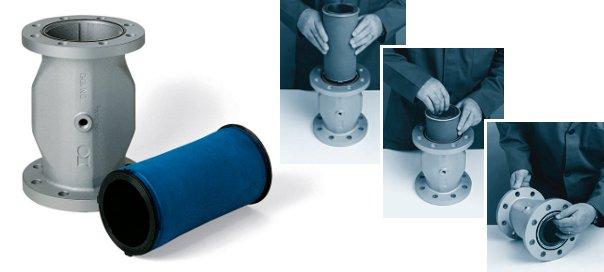The company HO-Matic has been specialising in the development and manufacture of high quality pneumatic pinch valves since 1977.
Hose pinch valves have proved themselves to be a universal problem-solver to close off even difficult media and those containing solids. The mode of operation is straightforward: an elastic tube-like shut-off component, which is placed in a metal or plastic housing, is used almost as an extension of the pipework in which the medium being conveyed is flowing. The hose sleeve is pressed together to close it either mechanically or pneumatically until the pipework is completely closed.
The space between the valve housing and elastic hose (usually elastomer) is described as a control space. If this control space is ventilated, the hose opens owing to its rebound resilience and the pressure of the medium inside the hose. The advantages of this design are obvious: the net weight of the mounting is relatively low compared with valves of the same nominal diameter. As a fairly large area of the hose acts as a sealing element, media containing fibres and solids can also be shut off reliably. In addition, the friction resistance of the mounting is very low compared with gate valves or conical seat valves – to close it only the compressive forces acting in the medium as well as the restoring forces of the elastomer need to be overcome. A further feature of hose pinch valves is that they do not become obstructed and require relatively little compressed air for the closing function. Pinch valves are used to block difficult media such as abrasive, fibrous, viscous or corrosive liquids and also solids. Valve design is increasingly also being used for adjustment control or dosage.
HO-Matic strives to satisfy our customers’ wishes as far as possible by offering good price/performance and extremely friendly service.
For example QSV (Quick Service Valve) – the patented solution.
The hose sleeve, which is subject to natural abrasion, can be replaced quickly in a matter of minutes by using a bayonet system (see image above). Downtimes of equipment are therefore reduced to a minimum. Replacement valves or special tools to mount sleeves are superfluous – an obvious sales advantage!
The system of sleeve anchoring does not contain any tension fastening components, eliminating cross-section constrictions or undesired extraneous material in the media flow that might be caused by the latter. Only the elastomer of the sleeve comes into contact with the medium. The oval shape of the housing makes it possible to operate the sleeve with minimal control air consumption. This results in optimal flow, long service life and low energy costs.

